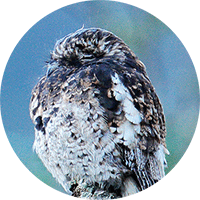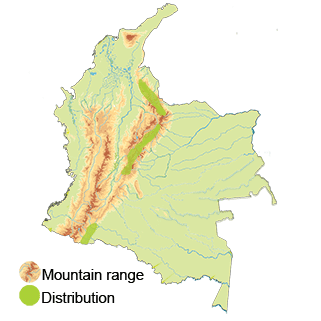Andean Potoo
The Andean Potoo (Nyctibius maculosus) Read in Spanish
Appearance: The Andean Potoo is a large, nocturnal bird known for its cryptic plumage, which resembles tree bark, allowing it to blend in seamlessly with its environment. It has mottled brown and gray feathers that provide excellent camouflage against tree branches where it roosts during the day. The bird has a large head, huge eyes, a wide mouth, and a distinctive bristled whisker-like rictal bristles around the bill.
Habitat: The Andean Potoo inhabits montane forests, cloud forests, and upper subtropical and temperate zones of the Andes. In Colombia, it can be found in mountainous regions with dense vegetation and foggy conditions, typically between 1,500 to 3,000 meters above sea level.
Behavior: Like other potoo species, the Andean Potoo is primarily nocturnal, hunting at night for insects. During the day, it roosts on tree branches, relying on its camouflage to avoid detection. The bird has a distinct upright posture when perched, resembling a broken branch or stump.
Breeding: The breeding behavior of the Andean Potoo is not extensively documented, but it is believed to engage in a similar courtship display and nesting behavior as other potoo species. The female usually lays one egg on a bare branch, and both parents share the responsibilities of incubating the egg and caring for the chick.
Conservation Status: The Andean Potoo faces threats such as habitat loss and fragmentation due to deforestation, agriculture, and human development. While specific data on the conservation status of the Andean Potoo in Colombia is limited, the species is generally considered to be of least concern according to the IUCN Red List.
Distribution
The Andean Potoo (Nyctibius maculosus)
Eastern Andes: In the Eastern Andes of Colombia, which includes departments like Boyacá, Cundinamarca, and Santander, the Andean Potoo can also be spotted in suitable highland habitats. This region offers diverse ecosystems and altitudinal gradients that the bird likely utilizes for foraging and roosting.
Northern Andes: The Northern Andes region of Colombia, encompassing departments like Norte de Santander and Cauca, is another area where the Andean Potoo may be found. The bird's presence in this region highlights its adaptability to varying habitats within the Andean mountain range.
Taxonomy
The Andean Potoo (Nyctibius maculosus)
- Kingdom: Animalia
- Phylum: Chordata
- Class: Aves (Birds)
- Order: Caprimulgiformes
- Family: Nyctibiidae
- Genus: Nyctibius
- Species: Nyctibius grandis
Vocalization
The vocalizations of the Andean Potoo (Nyctibius maculosus) are an essential aspect of its communication.
- Song: The Andean Potoo's vocalizations include a series of mournful and eerie vocalizations that are often described as a deep, resonant "whooo-ah" sound. This call can be repeated at intervals and is typically heard during the night, serving as a means of communication between individuals and potentially to establish territories.
- Hooting and Growling Sounds: In addition to the distinctive "whooo-ah" call, the Andean Potoo may also produce hooting or growling sounds, especially during courtship displays or interactions with other birds. These sounds can vary in pitch and intensity, conveying different messages to conspecifics.
- Bill Clapping and Wing Snapping: The Andean Potoo may also engage in bill clapping or wing snapping as part of its vocal repertoire. Bill clapping involves the rapid clapping of the bird's bill, creating sharp percussive sounds. Wing snapping occurs when the bird rapidly flutters its wings, producing a rustling noise that can be heard in the forest at night.





